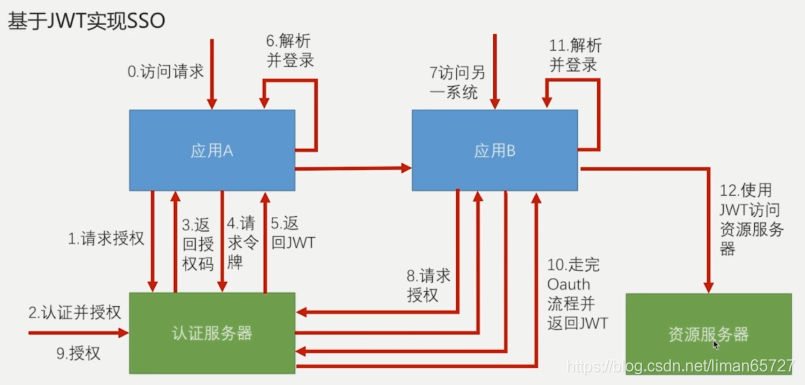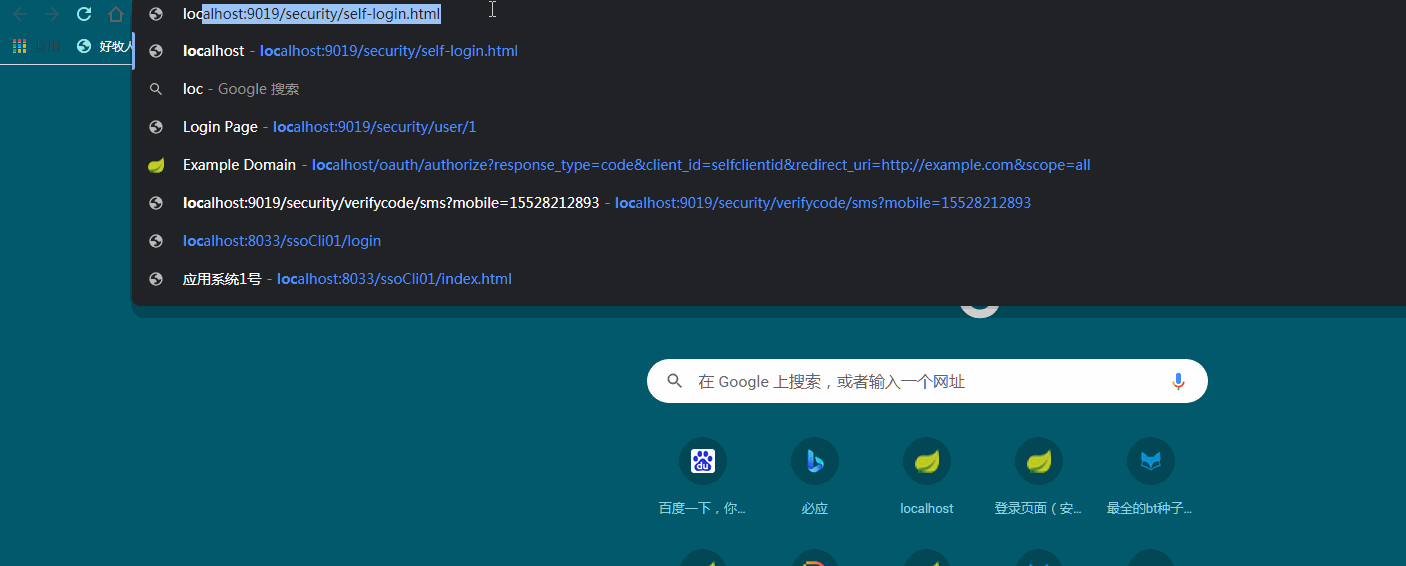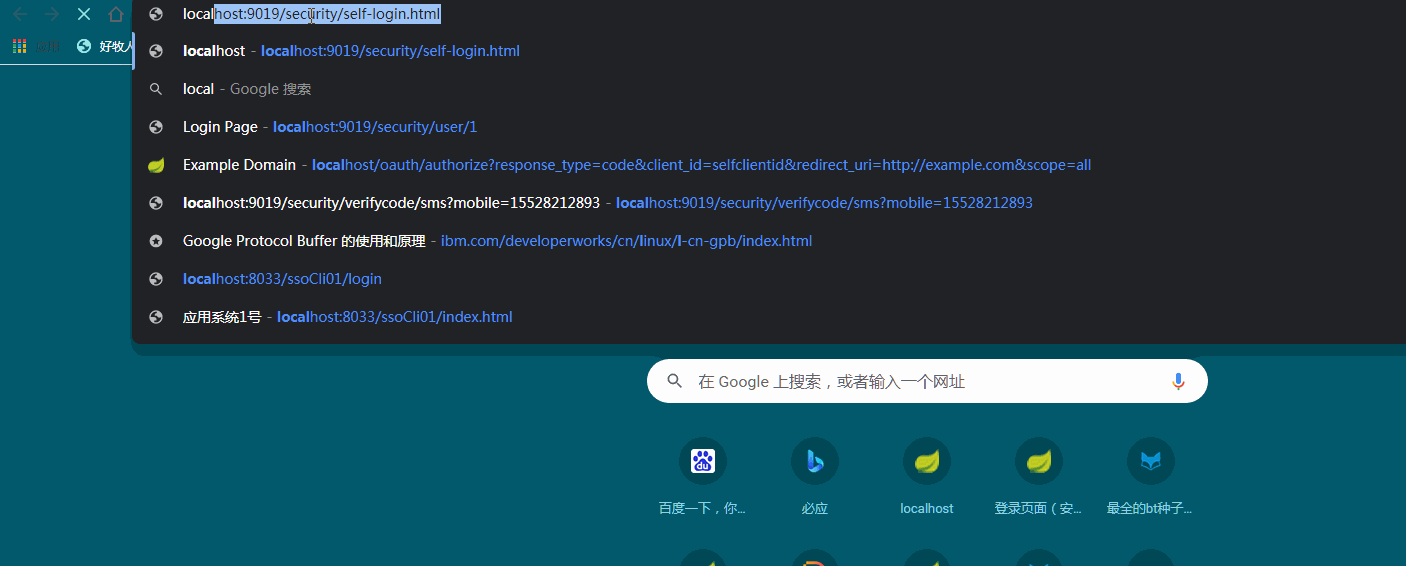前言
上一篇博客总结了自定义token,以JWT为例,简单总结了自定义token的一些配置与实例,这一篇博客在原有的基础上,基于JWT完成SSO的一个简单的实例,利用spring security+spring security oauth+spring security jwt,很容易就能开发出一个简单的SSO的应用,几乎不用写什么代码。
何为SSO
SSO即为单点登录,针对何为单点登录,这里依旧不做太多细致的总结。推荐几个介绍SSO的博客文章
具体流程如下图所示:

这个时候的认证服务器已经完全独立的,多个应用之前其实本身是跨域的,应用本身并不做认证的逻辑,所有的认证逻辑均在认证服务器上。
基于JWT实现一个简单的SSO,我们也要建三个简单的应用,现在梳理一下图中的步骤
0、用户访问应用A
1、应用A将用户请求跳转到认证服务器上
2、用户在认证服务器上认证并授权(用户认证的动作是在认证服务器上做的,不是在应用A上做的)
3、返回授权码给应用A
4、应用A根据得到的授权码换取令牌
5、应用A根据令牌组装生成的JWT返回给应用A
6、应用A解析JWT并完成登录。
7、之后用户访问应用B(另一个应用)
8、授权操作依旧被导向到认证服务器
9、用户在认证服务器完成对应用B的访问授权
10、应用B走完应用A换取JWT的流程(这一步认证服务器发送给应用B的JWT与应用A并不是一个,虽然解析出来都是同一个用户信息,但并不是同一个JWT)
11、用户在应用B上完成登录
12、用户根据JWT访问应用的资源(可以任意访问应用A或应用B的资源)
准备工作
前面说了,需要准备三个应用,一个表示认证服务器,一个标示应用A,一个表示应用B。

这里为了简单管理依赖,引入了一个spring-security-sso来管理各个项目的依赖。spring-security-sso-client1和spring-security-sso-client2表示两个应用。spring-security-sso-server表示认证服务器。
引入相关依赖
1、spring-security-sso中的依赖配置,主要是管理与子项目的依赖管理
<?xml version="1.0" encoding="UTF-8"?>
<project xmlns="http://maven.apache.org/POM/4.0.0"
xmlns:xsi="http://www.w3.org/2001/XMLSchema-instance"
xsi:schemaLocation="http://maven.apache.org/POM/4.0.0 http://maven.apache.org/xsd/maven-4.0.0.xsd">
<modelVersion>4.0.0</modelVersion>
<groupId>com.coderman.learn</groupId>
<artifactId>spring-security-sso</artifactId>
<version>1.0-SNAPSHOT</version>
<properties>
<project.build.sourceEncoding>UTF-8</project.build.sourceEncoding>
<java.version>1.8</java.version>
<maven.compiler.source>${java.version}</maven.compiler.source>
<maven.compiler.target>${java.version}</maven.compiler.target>
<lombok.version>1.16.10</lombok.version>
<javax-validation.version>2.0.1.Final</javax-validation.version>
<spring.boot.version>2.4.4</spring.boot.version>
</properties>
<dependencyManagement>
<dependencies>
<!--spring io 将具体的版本依赖交给spring IO 去管理-->
<dependency>
<groupId>io.spring.platform</groupId>
<artifactId>platform-bom</artifactId>
<version>Brussels-SR4</version>
<type>pom</type>
<scope>import</scope>
</dependency>
<!--以spring cloud相关组件为基础-->
<dependency>
<groupId>org.springframework.cloud</groupId>
<artifactId>spring-cloud-dependencies</artifactId>
<version>Dalston.SR2</version>
<type>pom</type>
<scope>import</scope>
</dependency>
</dependencies>
</dependencyManagement>
<build>
<plugins>
<!--指定编译的插件版本-->
<plugin>
<groupId>org.apache.maven.plugins</groupId>
<artifactId>maven-compiler-plugin</artifactId>
<version>2.3.2</version>
<configuration>
<source>1.8</source>
<target>1.8</target>
<encoding>UTF-8</encoding>
</configuration>
</plugin>
</plugins>
</build>
<modules>
<module>../spring-security-sso-server</module>
<module>../spring-security-sso-client01</module>
<module>../spring-security-sso-client02</module>
</modules>
</project>
2、认证服务器与sso-client的依赖配置如下,三者的依赖都一样
<?xml version="1.0" encoding="UTF-8"?>
<project xmlns="http://maven.apache.org/POM/4.0.0"
xmlns:xsi="http://www.w3.org/2001/XMLSchema-instance"
xsi:schemaLocation="http://maven.apache.org/POM/4.0.0 http://maven.apache.org/xsd/maven-4.0.0.xsd">
<modelVersion>4.0.0</modelVersion>
<parent>
<groupId>com.coderman.learn</groupId>
<artifactId>spring-secrity-learn-parent</artifactId>
<version>1.0.0-SNAPSHOT</version>
<relativePath>../spring-security-sso/pom.xml</relativePath>
</parent>
<groupId>com.coderman.learn</groupId>
<artifactId>spring-security-sso-server</artifactId>
<version>1.0-SNAPSHOT</version>
<dependencies>
<!--spring security的依赖-->
<dependency>
<groupId>org.springframework.boot</groupId>
<artifactId>spring-boot-starter-security</artifactId>
</dependency>
<!--web mvc的依赖-->
<dependency>
<groupId>org.springframework.boot</groupId>
<artifactId>spring-boot-starter-web</artifactId>
</dependency>
<!--spring oauth2的依赖-->
<dependency>
<groupId>org.springframework.security.oauth</groupId>
<artifactId>spring-security-oauth2</artifactId>
</dependency>
<!--生成的令牌是JWT的,所以要有JWT的依赖-->
<dependency>
<groupId>org.springframework.security</groupId>
<artifactId>spring-security-jwt</artifactId>
</dependency>
</dependencies>
</project>
认证服务的配置
spring-security-sso-server是模拟的认证服务器的角色,既然是认证服务器的角色,自然需要有认证服务器相关的配置,首先需要做的是开启@EnableAuthorizationServer注解,相关代码如下所示
/**
* autor:liman
* createtime:2021/8/16
* comment:
*/
@Configuration
//有了这个注解,我们的应用就是一个OAuth认证服务器了
@EnableAuthorizationServer
public class SsoAuthenticationServerConfig extends AuthorizationServerConfigurerAdapter {
/**
* 配置认证服务器的appid与appSecret(认证服务器可以给哪些应用访问),这里为了简单直接配置在内存里头
* @param clients
* @throws Exception
*/
@Override
public void configure(ClientDetailsServiceConfigurer clients) throws Exception {
clients.inMemory()
//第一个应用
.withClient("selfSSOClient01")
.secret("ssoClientSecret01")
.authorizedGrantTypes("authorization_code", "refresh_token")
.scopes("all")
.and()
//第二个应用
.withClient("selfSSOClient02")
.secret("ssoClientSecret02")
.authorizedGrantTypes("authorization_code", "refresh_token")
.scopes("all");
}
/**
* 配置获取签名的密钥需要通过认证
* @param security
* @throws Exception
*/
@Override
public void configure(AuthorizationServerSecurityConfigurer security) throws Exception {
//业务应用为了验证JWT需要获取认证服务器签发JWT的密钥
//这里配置的就是业务应用服务器为了获取认证服务器签发JWT的密钥,需要通过认证服务器的认证操作
security.tokenKeyAccess("isAuthenticated()");//获取签名的密钥需要认证
}
/**
* 生成令牌的配置
* @param endpoints
* @throws Exception
*/
@Override
public void configure(AuthorizationServerEndpointsConfigurer endpoints) throws Exception {
endpoints
.tokenStore(tokenStore())
.accessTokenConverter(jwtAccessTokenConverter());
}
//配置JWT的tokenStore
@Bean
public TokenStore tokenStore() {
return new JwtTokenStore(jwtAccessTokenConverter());
}
@Bean
public JwtAccessTokenConverter jwtAccessTokenConverter() {
JwtAccessTokenConverter accessTokenConverter = new JwtAccessTokenConverter();
String signKey = "self-sso-server";
accessTokenConverter.setSigningKey(signKey);//设置生成签名的密钥
return accessTokenConverter;
}
}
一些地址配置信息
##认证服务器的启动端口和context-path
server.port=8022
server.context-path=/ssoServer
##这里仅仅还是一个实例,直接简单的将认证用户密码在配置中写出
security.user.name=user
security.user.password=123456
应用服务的实例
应用服务端其实没什么需要做到,准备一个简单的业务接口,然后开启SSO配置,并配置一些信息即可。两个应用服务器的代码和配置都差别不大,只是有些自身的配置信息有些许差异,这里只贴出其中一个应用的即可。
1、启动类加入@EnableOAuth2Sso注解,这一步比较关键
/**
* autor:liman
* createtime:2021/8/16
* comment:
*/
@SpringBootApplication
@EnableOAuth2Sso//让sso生效
@RestController
public class SsoClient02Application {
@GetMapping("/user")
public Authentication user(Authentication user) {
return user;
}
public static void main(String[] args) {
SpringApplication.run(SsoClient02Application.class, args);
}
}
2、配置认证服务器的地址,以及认证服务器认证时所需要的appid和appSecret等信息
##应用本身的启动context-path和端口
server.port=8055
server.context-path=/ssoCli02
##appid和appsecret
security.oauth2.client.clientId = selfSSOClient02
security.oauth2.client.clientSecret = ssoClientSecret02
##认证服务器接受认证的接口地址,这里的地址和端口要与认证服务器中的配置一致
security.oauth2.client.user-authorization-uri = http://127.0.0.1:8022/ssoServer/oauth/authorize
##获取根据授权码去请求令牌的地址
security.oauth2.client.access-token-uri = http://127.0.0.1:8022/ssoServer/oauth/token
##去认证服务器获取解析JWT的密钥的地址
security.oauth2.resource.jwt.key-uri = http://127.0.0.1:8022/ssoServer/oauth/token_key
两个应用都差不多,无需要其他额外代码,目前几乎已经成功完成了SSO实例的所有开发
验证测试
为了测试方便,我们需要在应用服务器上准备一个简单的页面——index.html
<!DOCTYPE html>
<html>
<head>
<meta charset="UTF-8">
<title>应用系统1号</title>
</head>
<body>
<h1>应用系统1号</h1>
<a href="http://127.0.0.1:8055/ssoCli02/index.html">访问应用系统2号</a>
</body>
</html>
我们访问应用服务器这个页面就需要认证,这个时候应用服务器就会跳转到认证服务器,引导用户完成认证,认证完成之后才会回到这个页面
先启动认证服务器,之后启动两个应用服务器,直接访问任意一台应用服务器中的index.html
启动各个系统之后,简单的测试动图如下

在访问应用系统1的时候,可以清楚的看到浏览器中的认证地址已经跳转到认证服务器的地址,并要求输入用户名和密码。之后弹出了认证授权的窗口,点击确认,即可顺利的登入应用系统1。
之后在应用系统1中访问应用系统2的时候,便不需要认证的过程,只需要授权的过程即可。在应用系统1与应用系统2均认证完成之后,应用系统间便可以互相访问了。
一些锦上添花的内容
上面我们看到了简单的配置,即可实现一个SSO的登录认证。但是有些可以简单优化一下,关于认证,我们可以整成表单的模式,认证服务器的认证,我们希望通过从数据库中读取信息进行认证,而不是在配置文件中配置用户名和密码。这些也不是很难
登录认证改为表单认证
1、加入自定义的userDetailsServer
/**
* autor:liman
* createtime:2021/8/17
* comment:自定义的userDetailsServer
*/
@Component
public class SsoUserDetailsService implements UserDetailsService {
@Override
public UserDetails loadUserByUsername(String username) throws UsernameNotFoundException {
return new User(username,"123456",
AuthorityUtils.commaSeparatedStringToAuthorityList("ROLE_USER"));
}
}
2、相关认证的配置
/**
* autor:liman
* createtime:2021/8/17
* comment:关于认证的表单登录已经认证操作的配置
*/
@Configuration
public class SsoSecurityConfig extends WebSecurityConfigurerAdapter {
@Autowired
private UserDetailsService userDetailsService;
//表单登录
@Override
protected void configure(HttpSecurity http) throws Exception {
http.formLogin().and().authorizeRequests().anyRequest().authenticated();
}
//通过默认的userDetailsService进行用户认证
@Override
protected void configure(AuthenticationManagerBuilder auth) throws Exception {
auth.userDetailsService(userDetailsService);
}
}
简单的取消授权页面
在最初版本的实例中,我们需要点击approval之后,才能完成授权,在实际中,几乎不会存在这种情况,这里介绍一个比较low的方式取消这种页面点击授权的过程。
页面点击授权的表单是在spring security oauth2中的某一个EndPoint中提供的(具体为:org.springframework.security.oauth2.provider.endpoint.WhitelabelApprovalEndpoint)
EndPoint上有一个@FrameworkEndPoint的注解,这个注解和controller注解的左右几乎一样。我们需要做的就是copy这个类的源码,然后在我们自己的代码中将@FrameworkEndPoint改成@RestController,这样spring mvc请求的时候,会进入到我们自己定义的处理逻辑中,代码如下
/**
* autor:liman
* createtime:2021/8/17
* comment:
*/
@RestController
@SessionAttributes("authorizationRequest")
public class SsoApprovalEndpoint {
@RequestMapping("/oauth/confirm_access")
public ModelAndView getAccessConfirmation(Map<String, Object> model, HttpServletRequest request) throws Exception {
String template = createTemplate(model, request);
if (request.getAttribute("_csrf") != null) {
model.put("_csrf", request.getAttribute("_csrf"));
}
return new ModelAndView(new SsoSpelView(template), model);
}
protected String createTemplate(Map<String, Object> model, HttpServletRequest request) {
String template = TEMPLATE;
if (model.containsKey("scopes") || request.getAttribute("scopes") != null) {
template = template.replace("%scopes%", createScopes(model, request)).replace("%denial%", "");
}
else {
template = template.replace("%scopes%", "").replace("%denial%", DENIAL);
}
if (model.containsKey("_csrf") || request.getAttribute("_csrf") != null) {
template = template.replace("%csrf%", CSRF);
}
else {
template = template.replace("%csrf%", "");
}
return template;
}
private CharSequence createScopes(Map<String, Object> model, HttpServletRequest request) {
StringBuilder builder = new StringBuilder("<ul>");
@SuppressWarnings("unchecked")
Map<String, String> scopes = (Map<String, String>) (model.containsKey("scopes") ? model.get("scopes") : request
.getAttribute("scopes"));
for (String scope : scopes.keySet()) {
String approved = "true".equals(scopes.get(scope)) ? " checked" : "";
String denied = !"true".equals(scopes.get(scope)) ? " checked" : "";
String value = SCOPE.replace("%scope%", scope).replace("%key%", scope).replace("%approved%", approved)
.replace("%denied%", denied);
builder.append(value);
}
builder.append("</ul>");
return builder.toString();
}
private static String CSRF = "<input type='hidden' name='${_csrf.parameterName}' value='${_csrf.token}' />";
private static String DENIAL = "<form id='denialForm' name='denialForm' action='${path}/oauth/authorize' method='post'><input name='user_oauth_approval' value='false' type='hidden'/>%csrf%<label><input name='deny' value='Deny' type='submit'/></label></form>";
//这里返回的模板中,加入自动提交的js脚本(这种方式比较low),这样提交就默认确认了
private static String TEMPLATE = "<html><body><div style = 'display:none'><h1>OAuth Approval</h1>"
+ "<p>Do you authorize '${authorizationRequest.clientId}' to access your protected resources?</p>"
+ "<form id='confirmationForm' name='confirmationForm' action='${path}/oauth/authorize' method='post'><input name='user_oauth_approval' value='true' type='hidden'/>%csrf%%scopes%<label><input name='authorize' value='Authorize' type='submit'/></label></form>"
+ "%denial%</div><script>document.getElementById('confirmationForm').submit()</script></body></html>";
private static String SCOPE = "<li><div class='form-group'>%scope%: <input type='radio' name='%key%'"
+ " value='true'%approved%>Approve</input> <input type='radio' name='%key%' value='false'%denied%>Deny</input></div></li>";
}
方法getAccessConfirmation需要返回一个SpelView由于SpelView不是公共类,因此我们也需要自定义
/**
* autor:liman
* createtime:2021/8/17
* comment:
*/
public class SsoSpelView implements View {
private final String template;
private final String prefix;
private final SpelExpressionParser parser = new SpelExpressionParser();
private final StandardEvaluationContext context = new StandardEvaluationContext();
private PropertyPlaceholderHelper.PlaceholderResolver resolver;
public SsoSpelView(String template) {
this.template = template;
this.prefix = new RandomValueStringGenerator().generate() + "{";
this.context.addPropertyAccessor(new MapAccessor());
this.resolver = new PropertyPlaceholderHelper.PlaceholderResolver() {
public String resolvePlaceholder(String name) {
Expression expression = parser.parseExpression(name);
Object value = expression.getValue(context);
return value == null ? null : value.toString();
}
};
}
public String getContentType() {
return "text/html";
}
public void render(Map<String, ?> model, HttpServletRequest request, HttpServletResponse response)
throws Exception {
Map<String, Object> map = new HashMap<String, Object>(model);
String path = ServletUriComponentsBuilder.fromContextPath(request).build()
.getPath();
map.put("path", (Object) path==null ? "" : path);
context.setRootObject(map);
String maskedTemplate = template.replace("${", prefix);
PropertyPlaceholderHelper helper = new PropertyPlaceholderHelper(prefix, "}");
String result = helper.replacePlaceholders(maskedTemplate, resolver);
result = result.replace(prefix, "${");
response.setContentType(getContentType());
response.getWriter().append(result);
}
}
完成这些,再启动项目,SSO,就会变成表单登录,且不会自动跳出授权认证页面。测试结果如下动图所示:

总结
基于spring security总结了一个简单的SSO实例。
相关代码地址——spring security sso开头的项目模块。